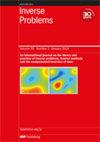旅行时间断层摄影的稳定性和统计反演
IF 2
2区 数学
Q1 MATHEMATICS, APPLIED
引用次数: 0
摘要
在本文中,我们考虑了有界域上共形度量的旅行时间断层扫描问题,该问题旨在通过连接边界点的大地线长度确定度量的共形因子。我们在一些先验条件下建立了简单保角度量的正向和反向稳定性估计。然后,我们应用这些稳定性估计值来证明贝叶斯统计反演技术在离散、噪声测量的旅行时间断层摄影中的一致性。本文章由计算机程序翻译,如有差异,请以英文原文为准。
Stability and statistical inversion of travel time tomography
In this paper, we consider the travel time tomography problem for conformal metrics on a bounded domain, which seeks to determine the conformal factor of the metric from the lengths of geodesics joining boundary points. We establish forward and inverse stability estimates for simple conformal metrics under some a priori conditions. We then apply the stability estimates to show the consistency of a Bayesian statistical inversion technique for travel time tomography with discrete, noisy measurements.
求助全文
通过发布文献求助,成功后即可免费获取论文全文。
去求助
来源期刊

Inverse Problems
数学-物理:数学物理
CiteScore
4.40
自引率
14.30%
发文量
115
审稿时长
2.3 months
期刊介绍:
An interdisciplinary journal combining mathematical and experimental papers on inverse problems with theoretical, numerical and practical approaches to their solution.
As well as applied mathematicians, physical scientists and engineers, the readership includes those working in geophysics, radar, optics, biology, acoustics, communication theory, signal processing and imaging, among others.
The emphasis is on publishing original contributions to methods of solving mathematical, physical and applied problems. To be publishable in this journal, papers must meet the highest standards of scientific quality, contain significant and original new science and should present substantial advancement in the field. Due to the broad scope of the journal, we require that authors provide sufficient introductory material to appeal to the wide readership and that articles which are not explicitly applied include a discussion of possible applications.
 求助内容:
求助内容: 应助结果提醒方式:
应助结果提醒方式:


